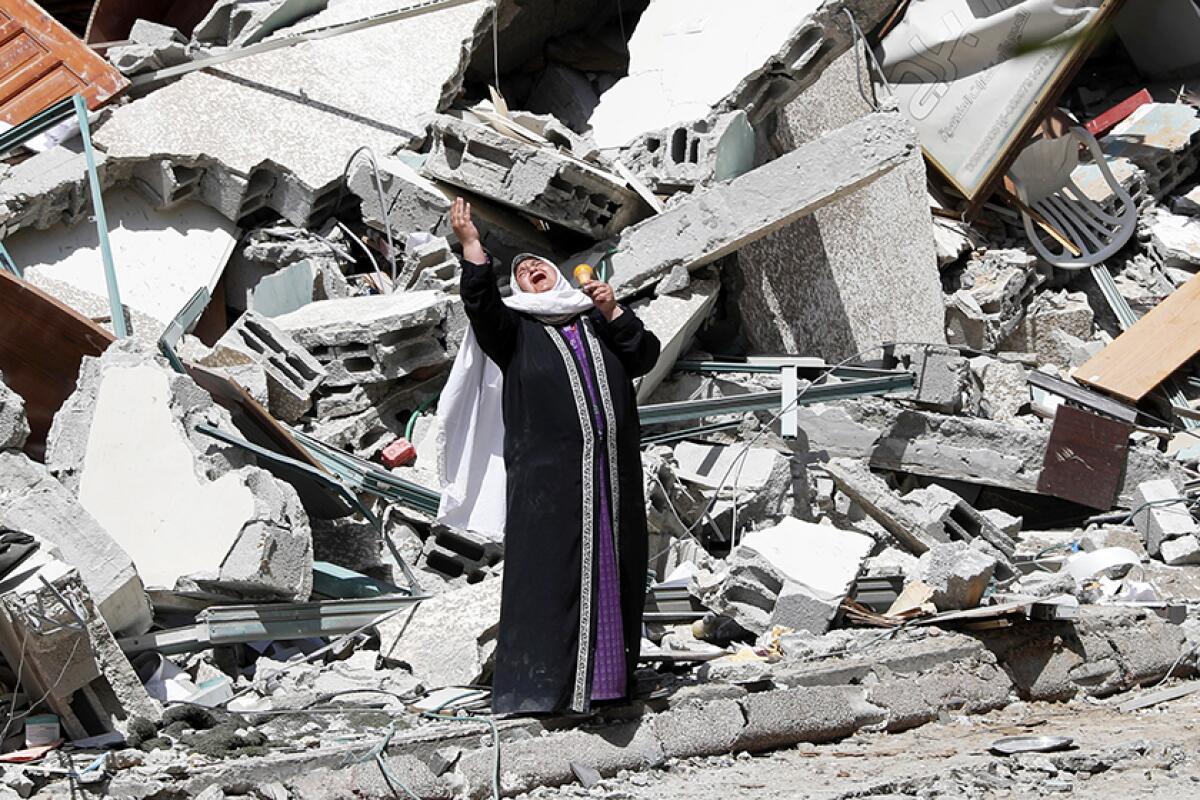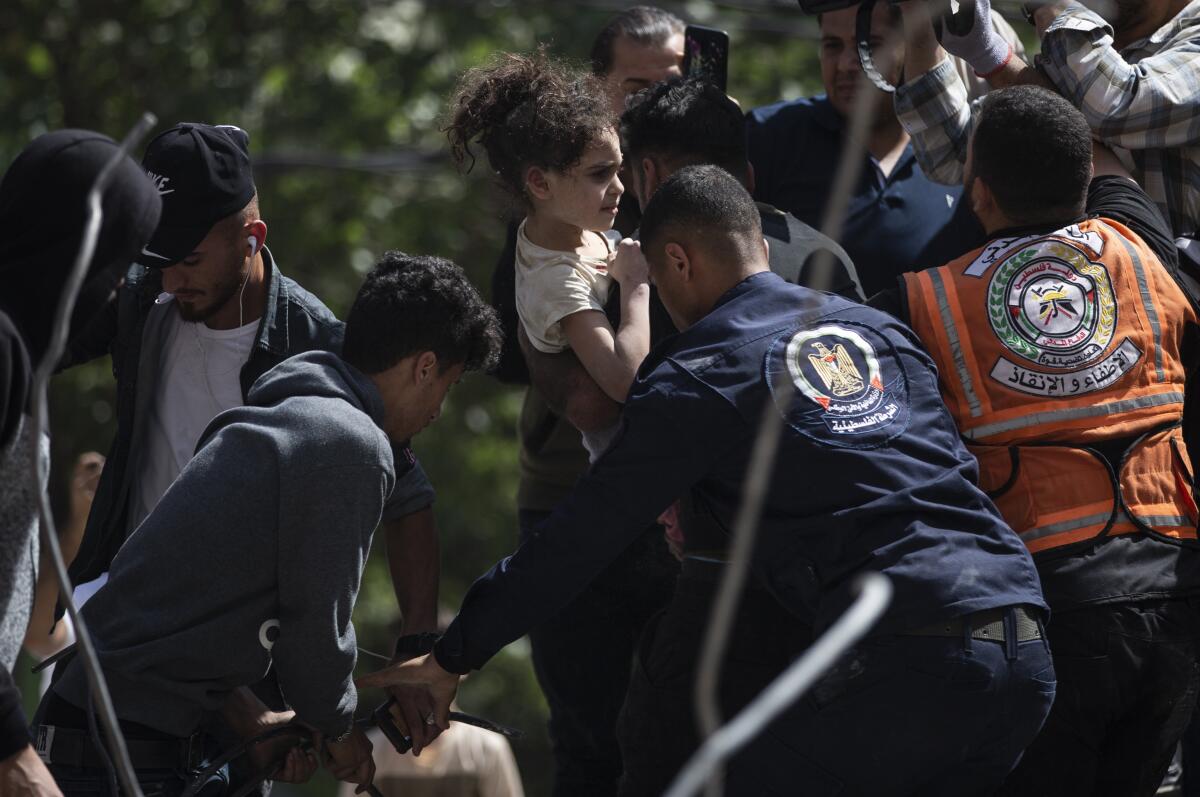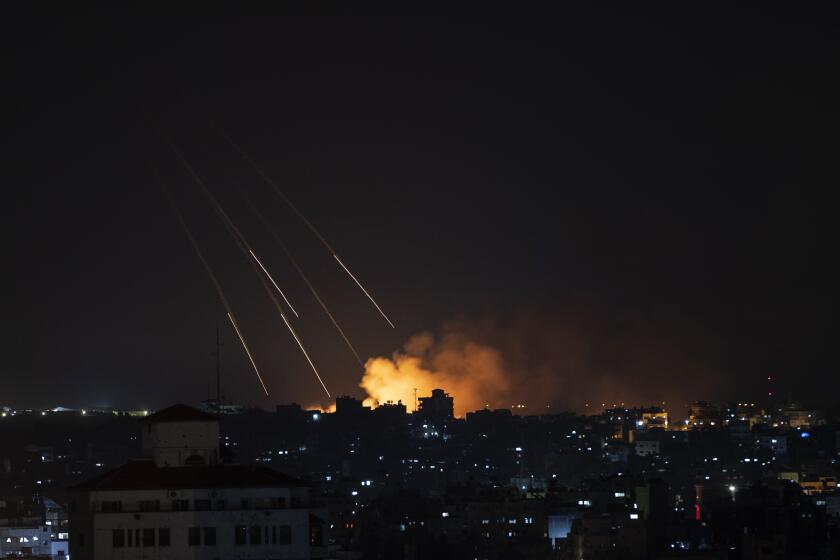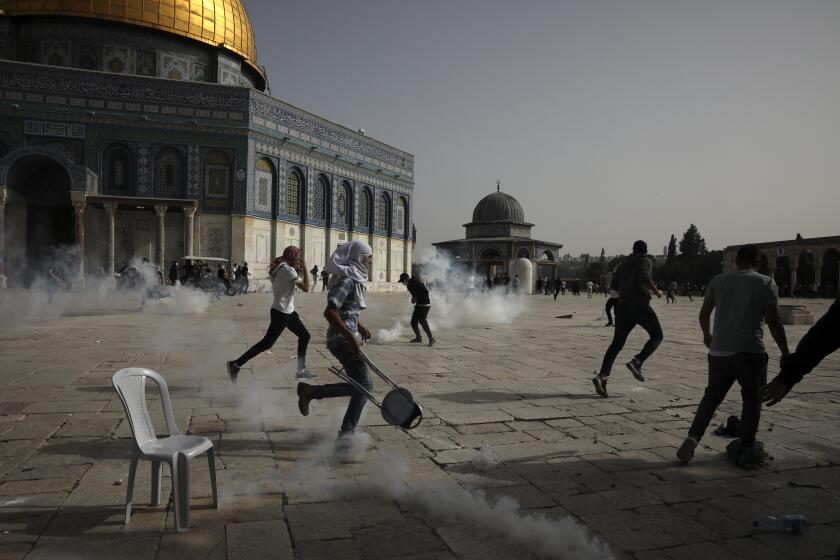Israeli strikes kill at least 42, topple buildings in Gaza City, as Netanyahu warns war will go on

- Share via
GAZA CITY — Israeli airstrikes on Gaza City flattened three buildings and killed at least 42 people Sunday, Palestinian medics said, in the deadliest single attack in the latest round of violence. Despite the toll and international efforts to broker a cease-fire, Israeli Prime Minister Benjamin Netanyahu signaled the fourth war with Gaza’s Hamas rulers would rage on.
In a televised address, Netanyahu said the attacks were continuing at “full-force” and would “take time.“ Israel “wants to levy a heavy price” on the Hamas militant group, he said, flanked by his defense minister and political rival, Benny Gantz, in a show of unity.
And early Monday morning in the Middle East, Israeli warplanes unleashed a new series of heavy airstrikes at several locations of Gaza City.
Explosions rocked the city from north to south for 10 minutes in an attack that was heavier, on a wider area and lasted longer than the air raids 24 hours earlier. Local media reports said the main coastal road west of the city, security compounds and open spaces were among the targets hit early Monday. The power distribution company said the airstrikes damaged a line feeding electricity from the only power plant to large parts of southern Gaza City.
There were no immediate reports of injuries.
Hamas also pressed on Sunday, launching rockets from civilian areas in Gaza toward civilian areas in Israel. One slammed into a synagogue in the southern city of Ashkelon hours before evening services for the Jewish holiday of Shavuot, Israeli emergency services said. No injuries were reported.
In the Israeli air assault early Sunday, families were buried under piles of cement rubble and twisted rebar. A yellow canary lay crushed on the ground. Shards of glass and debris covered streets blocks away from the major downtown thoroughfare where the three buildings were hit over the course of five minutes around 1 a.m.
The hostilities have repeatedly escalated over the past week, marking the worst fighting in the territory that is home to 2 million Palestinians since Israel and Hamas’ devastating 2014 war.
“I have not seen this level of destruction through my 14 years of work,” said Samir al-Khatib, an emergency rescue official in Gaza. “Not even in the 2014 war.”
Rescuers furiously dug through the rubble using excavators and bulldozers amid clouds of heavy dust. One shouted, “Can you hear me?” into a hole. “Are you OK?” he asked. Minutes later, first responders pulled a survivor out. The Gaza Health Ministry said 16 women and 10 children were among those killed, with more than 50 people wounded.
Haya Abdelal, 21, who lives in a building next to one that was destroyed, said she was sleeping when the airstrikes sent her fleeing into the street. She accused Israel of not giving its usual warning to residents to leave before launching such an attack.
“We are tired,” she said. “We need a truce. We can’t bear it anymore.”
The Israeli army spokesperson’s office said the strike targeted Hamas “underground military infrastructure.” As a result of the strike, “the underground facility collapsed, causing the civilian houses’ foundations above them to collapse as well, leading to unintended casualties,” it said.
Among those reported killed was Dr. Ayman Abu Al-Ouf, the head of the internal medicine department at Shifa Hospital and a senior member of the hospital’s coronavirus management committee. Two of Abu Al-Ouf’s teenage children and two other family members were also buried under the rubble.
The death of the 51-year-old physician “was a huge loss at a very sensitive time,” said Mohammed Abu Selmia, the director of Shifa.
Gaza’s healthcare system, already gutted by an Israeli and Egyptian blockade imposed after Hamas seized power from rival Palestinian forces in 2007, had been struggling with a surge in coronavirus infections even before the latest conflict.
Short of surrender, no conflict in the world can be solved by military means. Any resolution depends on negotiations with your enemies, not friends.
Israel’s airstrikes have leveled a number of Gaza City’s tallest office and residential buildings, alleging they contain Hamas military infrastructure. Among them was the building housing the Associated Press office and those of other media outlets.
Sally Buzbee, the AP’s executive editor, called for an independent investigation into the airstrike that destroyed the AP office Saturday.
Netanyahu alleged that Hamas military intelligence was operating inside the building and said Sunday that Israel had shared what it said was evidence of Hamas’ presence through intelligence channels. Neither the White House nor the State Department would say if any American official had seen it.
“It’s a perfectly legitimate target,” Netanyahu told CBS’s “Face the Nation.”
Asked if he had provided any evidence of Hamas’ presence in the building in a call Saturday with President Biden, Netanyahu said: “We pass it through our intelligence people.”
Buzbee called for any such evidence to be laid out.
“We are in a conflict situation,” Buzbee said. “We do not take sides in that conflict. We heard Israelis say they have evidence; we don’t know what that evidence is.”
The AP had operated from the building for 15 years, including through three previous wars between Israel and Hamas. The news agency’s cameras, operating from its top floor office and roof terrace, offered 24-hour live shots as militants’ rockets arched toward Israel and Israeli airstrikes hammered the city and its surroundings.
The latest outbreak of violence began in East Jerusalem last month, when Palestinians clashed with police in response to Israeli police tactics during Ramadan and the threatened eviction of dozens of Palestinian families by Jewish settlers. A focus of the clashes was the Al-Aqsa Mosque, a frequent flashpoint located on a hilltop compound revered by both Muslims and Jews.
Hamas began firing rockets toward Jerusalem on Monday, triggering the Israeli assault on Gaza.

At least 188 Palestinians have been killed in the hundreds of airstrikes in Gaza, including 55 children and 33 women, with 1,230 people wounded. Eight people in Israel have been killed in some of the 3,100 rocket attacks launched from Gaza, including a 5-year-old boy and a soldier.
Hamas and the Islamic Jihad militant group have acknowledged 20 fighters killed in the fighting. Israel says the real number is far higher and has released the names and photos of two dozen alleged operatives it says were “eliminated.”
The assault has displaced some 34,000 Palestinians from their homes, United Nations Mideast envoy Tor Wennesland told an emergency meeting of the U.N. Security Council, where eight foreign ministers spoke about the conflict.
Efforts by China, Norway and Tunisia to get the U.N. body to issue a statement, including a call for the cessation of hostilities, have been blocked by the United States, which, according to diplomats, is concerned it could interfere with diplomatic efforts to stop the violence.
Palestinian Authority Foreign Minister Riyad Maliki urged the Security Council to take action to end Israeli attacks. Israel’s U.N. ambassador, Gilad Erdan, urged the council to condemn Hamas’ “indiscriminate and unprovoked attacks.”
Palestinian protesters and Israeli police have faced off on a daily basis for weeks in and around Jerusalem’s Old City, a frequent site of conflict.
The turmoil has also fueled protests in the occupied West Bank and stoked violence within Israel between its Jewish and Arab citizens, with clashes and vigilante attacks on people and property.
On Sunday, a driver rammed into an Israeli checkpoint in the East Jerusalem neighborhood of Sheikh Jarrah — where Palestinian families have been threatened with eviction — injuring six officers before police shot and killed the attacker, Israeli police said.
The violence also sparked pro-Palestinian protests in cities across Europe and the United States.
Israel appears to have stepped up strikes in recent days to inflict as much damage as possible on Hamas as international mediators work to end the fighting and stave off an Israeli ground invasion in Gaza.
The Israeli military said it destroyed the home Sunday of Gaza’s top Hamas leader, Yahiyeh Sinwar, in the southern town of Khan Younis. It was the third such attack in the last two days on the homes of senior Hamas leaders, who have gone underground.
More to Read
Sign up for Essential California
The most important California stories and recommendations in your inbox every morning.
You may occasionally receive promotional content from the Los Angeles Times.












